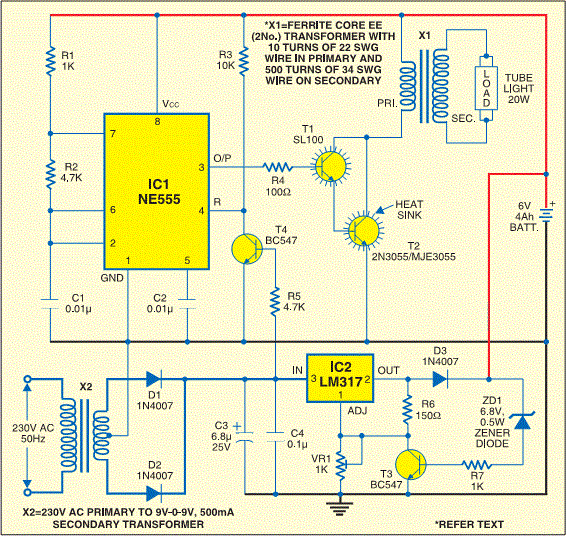Nowadays, an automatic emergency light is a very important tool in our daily lives. An automatic emergency light is a battery-backed lighting device that turns on automatically when we experience a power outage. Emergency lights are standard in new commercial and high occupancy residential buildings, such as college dormitories. Most building codes require that they be installed in older buildings as well.
The circuit I am going to share is a fully automated circuit which turns off charging automatically when the battery is fully charged so you can keep it connected to your wall socket all day long without worrying about over charging issues.
Components Required:
- NE555 IC
- LM317 IC
- Ferrite Transformer with 22 primary and 34 secondary turns
- Center Taped Step down transformer 500mA 9V-0-9V
- Tubelight 20W
- 6V 4Ah Battery
- SL100 Transistor (with heat sink)
- 2N3055/MJE3055 Transistor (with heat sink)
- 2x BC547 Transistor
- 3x 1N4007 Diode
- Zener diode 6.8V (0.5W)
- 2x 0.01 uF Capacitor
- 0.1 uF Capacitor
- 6.8 uF Capacitor (25V)
- Pot 1 Kohm Variable Resistor
- 2x 1 Kohm Resistor
- 2x 4.7 Kohm Resistor
- 10 Kohm Resistor
- 100 ohm Resistor
- 150 ohm Resistor
Circuit Diagram:
The circuit can be divided into inverter and charger sections. The inverter section is built around timer NE555, while the charger section is built around 3-terminal adjustable regulator LM317. In the inverter section, NE555 is wired as an astable multivibrator that produces a 15kHz squarewave. Output pin 3 of IC 555 is connected to the Darlington pair formed by transistors SL100 (T1) and 2N3055 (T2) via resistor R4.
The Darlington pair drives ferrite transformer X1 to light up the tubelight. For fabricating inverter transformer X1, use two EE ferrite cores (of 25×13×8mm size each) along with plastic former. Wind 10 turns of 22 SWG on primary and 500 turns of 34 SWG wire on secondary using some insulation between the primary and secondary. To connect the tube-light to ferrite transformer X1, first short both terminals of each side of the tube-light and then connect to the secondary of X1. (You can also use a Darlington pair of transistors BC547 and 2N6292 for a 6W tube-light with the same transformer.)
Working:
When mains power is available, reset pin 4 of IC 555 is grounded via transistor T4. Thus, IC1 (NE555) does not produce square-wave and emergency light turns off in the presence of mains supply. When mains fails, transistor T4 does not conduct and reset pin 4 gets positive supply though resistor R3. IC1 starts producing square wave and tube-light turns on via ferrite transformer X1. In the charger section, input AC mains is stepped down by transformer X2 to deliver 9V-0-9V AC at 500mA. Diodes D1 and D2 rectify the output of the transformer. Capacitors C3 and C4 act as filters to eliminate ripples.
The unregulated DC voltage is fed to IC LM317 (IC2). By adjusting preset VR1, the output voltage can be adjusted to deliver the charging voltage. When the battery gets charged above 6.8V, zener diode ZD1 conducts and regulator IC2 stops delivering the charging voltage. Assemble the circuit on a general-purpose PCB and enclose in a cabinet with enough space for the battery and switches. Connect a 230V AC power plug to feed charging voltage to the battery and make a 20W tube outlet in the cabinet to switch on the tube-light.


















